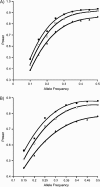Using cases and parents to study multiplicative gene-by-environment interaction
- PMID: 19483188
- PMCID: PMC2733309
- DOI: 10.1093/aje/kwp118
Using cases and parents to study multiplicative gene-by-environment interaction
Abstract
With case-parent triads, one can estimate genotype relative risks by measuring the apparent overtransmission of susceptibility genotypes from parents to affected offspring. Results obtained using such designs, properly analyzed, resist both bias due to population structure and bias due to self-selection. Most diseases are not purely genetic, and environmental cofactors can also be important. In this paper, the authors describe how a polytomous logistic regression method previously developed for studying genetic effects on a quantitative trait can be used with case-parent data to study multiplicative gene-by-environment interaction. The idea is that if the joint effect of exposure and genotype on risk is submultiplicative or supermultiplicative, then, conditional on the parental genotypes, inheritance of a susceptibility genotype by affected offspring will appear to have been influenced by the offspring's exposure level. The authors' approach tolerates exposure-complicated genetic population structure, and simulations suggest power and Type I error rates comparable to those of competitors. With this approach, one can estimate the usual interaction parameters under a much less stringent assumption than gene-environment independence in the source population. Incompletely genotyped triads can contribute through an expectation-maximization algorithm. To illustrate, the authors consider polymorphisms in detoxification pathway genes and maternal smoking in relation to the birth defect oral cleft.
Figures


References
-
- Wilcox AJ, Weinberg CR, Lie RT. Distinguishing the effects of maternal and offspring genes through studies of “case-parent triads”. Am J Epidemiol. 1998;148(9):893–901. - PubMed
Publication types
MeSH terms
Grants and funding
LinkOut - more resources
Full Text Sources
Medical

